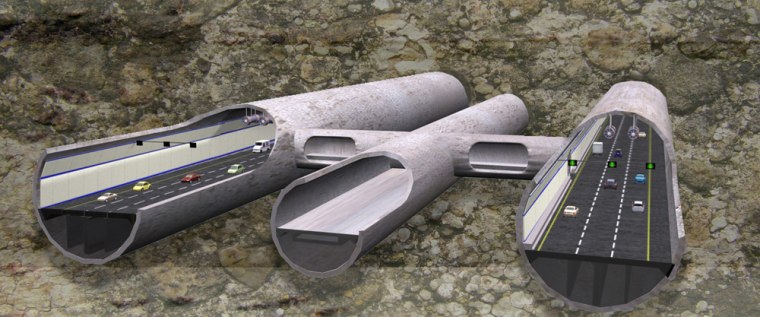It would be the world's longest highway tunnel, running more than 16 miles under the west end of Long Island Sound.
The cost is estimated at $10 billion — and it wouldn't cost taxpayers a dime. A developer wants to build the tunnel with private money, recouping his costs by charging drivers $25 each way and by selling advertising.
Developer Vincent Polimeni says the tunnel between Oyster Bay and Rye on the New York mainland would let travelers going between Long Island and New England avoid crowded New York City highways and help alleviate traffic congestion.
While not expected to be completed before 2025, the proposal received renewed attention this past week when a state Senate committee held a hearing.
Polimeni acknowledges his idea was initially met with "smirks and skepticism." But he added: "The more people looked at the plan, the larger circle of intrigued citizens who said `tell me more.'"
The tunnel also brought back memories of Robert Moses, the powerful New York municipal planner who was rebuffed in his bid to build a bridge over Long Island Sound three decades ago. Long Island officials savaged Moses for his plan.
"Considering that we're on Long Island, I'm amazed they didn't run me out of the room," Polimeni, a developer of malls and office buildings in the New York area and in Poland, cracked during a recess at the hearing Thursday. "I think it's a good sign."
'Intriguing' but 'unrealistic'
Oyster Bay Town Supervisor John Venditto described the project as "intriguing to say the least," but said his initial reaction was "it is unrealistic." He promised to review the data "so we don't have to make knee-jerk reactions and we can make an informed decision."
Elected officials from the proposed northern terminus were not as congenial.
"We cannot in Westchester (County) absorb the additional traffic that this tunnel would bring to our roads," said Rye Mayor Steven Otis. "It simply would make our roads nonfunctional."
He said the Westchester Municipal Officials Association voted in December to oppose the project.
Some Long Island residents agree with Otis' stand. Gino Longinotti of Syosset, just south of Oyster Bay, said he was curious about the project but didn't "see it being feasible. We have traffic conditions now where all the roads are congested."
Polimeni contends the estimated 80,000 vehicles a day using the tunnel would simply represent a shift in the roads being used, not an increase. He also argues the tunnel would ease air pollution because vehicles would be traveling shorter distances.
Polimeni has paid $250,000 out of his own pocket for engineering studies, and Bear, Stearns & Co. Inc. is providing investment banking advice.
Polimeni has also employed the engineering and construction firm Hatch Mott MacDonald, which has been involved in tunnel projects worldwide, including the 30-mile railroad "Chunnel" that connects Great Britain and France.
Longest tunnel now 15.2 miles
At 16 to 18 miles long, depending on the final design, the Long Island Sound project would eclipse Norway's 15.2-mile Laerdal Tunnel as the world's longest highway tunnel.
It would consist of two tubes carrying three lanes of traffic each, plus a central tunnel to be used for maintenance access and emergency ventilation and egress.
Where Moses — the man responsible for many of New York's major spans, including the Verrazano Narrows — failed in his bid to bridge the sound, Polimeni is not discouraged.
"Moses had the idea, only he was going to go up and over and nobody wanted to see this," he said.
The key to his strategy, is to take the project underground: "I thought, make it stealth."
